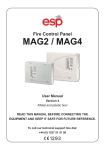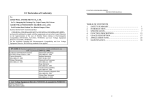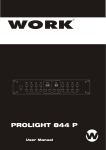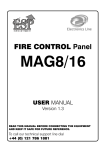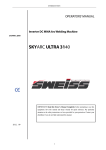Download AE-C5-2P ingles.pmd
Transcript
USER MANUAL FIRE CONTROL PANEL AE/C5-2P AE/C5-4P V1.1 Jun 06 INSTALLER Instructions Contents Page General Information ..................................................................................... 2 Using the controls ....................................................................................... 3 Indicators / Outputs ...................................................................................... 3 Engineers Facilities ..................................................................................... 3 Installing the Panel ...................................................................................... 4 Testing the Panel ......................................................................................... 4 Engineers Facilities ..................................................................................... 6 Connecting the Additional Facilities ............................................................ 7 Specification ................................................................................................. 8 Connection Circuits ..................................................................................... 9 Fire Alarm Record ...................................................................................... 10 Service Record ........................................................................................... 11 Fire Alarm Event Log .................................................................................. 11 WARNING This manual contains information on limitations regarding product use and function and information on the limitations as to liability of the manufacturer. The entire manual should be carefully read. General Information The system is to be installed by a qualified person to the latest Fire Alarm and Installation Regulations which are mandatory in the applicable country of installation. Before commencing the installation of this Fire Alarm Panel, ensure it is sited in a position, which is visible to the Fire Brigade when entering the premises, and where ease of access is provided for users and service engineers. Space must be available to easily open external and internal doors. The Electrical Supply to the panel must be isolated and must not be capable of being accidentally switched off. A ‘Lockable Switch fuse Unit’ positioned within 2 meters of the panel should be clearly labelled FIRE ALARM - DO NOT SWITCH OFF. EN 54-2 compatible panels. All specifications are subject to change without notice. 2 Using the Controls • Refer to the instructions on the inside of the outer door. Indications / Outputs NORMAL: • The green LED next to the ‘power Supply 230V AC’ will be illuminated. FIRE: • Two integrated red status FIRE LED’s and a zone identification LED will flash together on receipt of a FIRE condition and become steady after the Silence Alarm button is pressed. • An internal buzzer will operate until silenced. • The external sounders will operate. FAULT: • The FIRE relay will energize. • A yellow General Fault LED will always illuminate together with an external or internal identification LED. • An internal buzzer will sound. • The FAULT relay will de-energize. Faults are monitored as follows: • Zone fault - open or short circuit. Detector head removed. • Sounder Circuit One fault - open or short circuit, reverse connected sounder, or bad sounder parameters. • Sounder Circuit Two fault - open or short circuit, reverse connected sounder, or bad sounder parameters. • A.C. Loss or Battery charger fault. (“A.C. Loss” means Mains Supply) • Battery Loss. • Low Battery condition. • 24V DC Supply fault. • Processor fault. • Auxiliary supply fault. • Short circuit to earth. All fuses are monitored and will cause a fault condition should they fail. Selecting an ‘Engineers Facility’ will indicate and announce a Fault condition at the panel. NOTE: FAULT CONDITIONS WILL NOT BE ANNOUNCED INSTANTLY. THERE WILL BE A SHORT DELAY WHICH WILL VARY FROM CONDITION TO CONDITION. FAULTS WHEN CLEARED WILL AUTOMATICALLY RESET AT THE PANEL. Engineers Facilities: PANELS engineer facilities has the ability to during installation include: select various facilities to assist the and testing of the system. These Zone Test Isolate Sounders - System can be tested without operating the Sounder circuits. Disable / Enable Zone - Each zone can be disabled / enabled. 3 Installing the Panel • Decide the best location for the panel position, with an ambient temperature between 0 ºC /40 ºC, away from heating systems, environmental dust and potential water ingress. • Remove all packaging. • Inspect the panel for any damage. • Carefully remove the outer cover, by inserting unscrewing the two allen screws. Stow the cover in a safe position. • Inspect the internal PCB and make sure the internal components are firmly in place. • Observe the main PCB chassis and the associated securing screw, located in the front of the terminal blocks. • Unfasten the chassis securing screw and remove the chassis. Stow in a safe location. • Choose which cable entry points to knock out and carefully remove the knock-outs. • Observe the top center fixing location at the back of the panel. • Stow the back box in a safe position. • Drill the wall to suit the back box center fixing position, plug and insert a fixing screw. • Temporally hang the back box from the fixing screw and mark out the two bottom left and right fixing locations. • Remove the back box from the center fixing screw position and drill and plug the bottom fixing holes. • Hang the back box from the center fixing position and fix securing screws through the bottom fixing holes. • Tighten all the fixing screws. • Route the external cables onto the back box, make off connection glands etc., BUT DO NOT make any connections at this stage. ENTER THE MAINS CABLE THROUGH ITS OWN CABLE ENTRY POINT AND KEEP MAINS WIRING AWAY FROM SYSTEM AND OTHER LOW VOLTAGE WIRING. • Re-fit the PCB chassis and re-connect the chassis mains connection. • Connect the mains supply and earth to the main terminal block BUT DO NOT apply the main electrical supply at this stage. • Position the standby battery in an upright position. The panel is now ready for testing. Testing the Panel • Connect the battery leads from the black power supply box to the positive and negative battery terminals. • Apply the mains power. • If the buzzer and indicator LED’s are operating, press the RESET button. If in the Normal Operating Mode other LED’s are illuminated and the buzzer is sounding, carefully check that fuses and connections are sound. Refer to the part of the internal connections or circuitry the associated yellow LED’s apply to. The connection diagram on the inside of the external cover will assist in identifying the LED. NOTE: The battery might show a ‘Low Battery Fault’ initially until it has had time to charge up to the required level. 4 If by some chance the fault will not cancel, and only on the advice of our Technical Support Department, return the P.C.B. CHASSIS ONLY to your supplier. DO NOT return the plastic box. Once the panel is found to operate satisfactorily in the NORMAL MODE, it is time to connect the external circuits. It has been assumed that prior to making the connection at the panel, the integrity of the system ALL wiring has been comprehensively tested, including insulation to earth. • Isolate the mains supply and disconnect the battery connection. • Fit the Active End of Line Device to the last detection device of zone one. • Ensure all terminations are made correctly and all detector heads are plugged into their bases. • Connect Detector circuit ONE to the panel terminal block. • Power up the panel with the mains and battery. • Press RESET button. The panel should be in the ‘NORMAL MODE.’ NOTE: If General Fault and zone 1 FAULT LED’s illuminate, there is a wiring / connection problem. Check the polarity of the connection, the connection of the devices and whether a head is removed. Check the EOL proper polarity and position. • Operate ALL detection devices applicable to this zone, to ensure correct receipt of a fire signal and the correct operation of the panel controls. Refer to the User Instructions on the inside of the panel. • Repeat the connection process for zone two as stated above. ENSURE the supply voltages are initially disconnected prior to each stage. ONCE THE CONNECTION OF THE ZONES ARE COMPLETED, CONNECT AND TEST ANY OF THE OTHER AUXILIARY CIRCUITS BEFORE CONNECTING THE EXTERNAL SOUNDER CIRCUITS. Relay Connection - The onboard relay volt free change over terminals are for low voltage use only. MAINS SUPPLY MUST NOT BE APPLIED TO THESE TERMINALS. Once the zone and auxiliary circuits have been connected and tested to function correctly, it is time to connect the first external sounder circuit: • Isolate the mains supply and disconnect the battery connection. • Remove the End of Line Monitoring Resistor from the terminal block of sounder circuit 1 (SND 1) and fit to the last sounder of circuit one. • Check all sounder connections are made. • Connect sounder circuit ONE to the panel terminal block. • Apply mains and battery power. • Press RESET The panel should be in the ‘NORMAL MODE.’ Activate a zone Call Point. The sounders should operate. Press the reset button. Repeat the connection process for the second external sounder circuit, as stated above. ENSURE the supply voltages are initially disconnected prior to each stage. 5 NOTE: If General Fault and SOUNDER FAULT / DISABLE LED.’s illuminate, there is a wiring /connection problem. Check the polarity of the connection of each of the devices, the polarity of the connection of the devices to the Panel terminal block or whether an earth fault exists. Engineers Facilities: To Disable Zone 1: Press ENABLE / DISABLE button: Zone 1 lamp will flash. DISABLE / ENABLE lamp will flash. Press ENABLE / DISABLE button: The zone lamp will become steady. Press RESET: To Enable Zone 1: At this point the zone 1 is disabled. Press ENABLE / DISABLE button TWICE: Zone 1 lamp will flash. DISABLE / ENABLE lamp will flash. Press RESET. At this point the zone 1 is disabled. To Disable Zone 2: Press ENABLE / DISABLE button: Zone 1 lamp will flash. ENABLE / DISABLE lamp will flash. Press TEST / SCROLL button: Zone 2 lamp will flash. ENABLE / DISABLE lamp will flash. Press ENABLE / DISABLE button: Zone 2 lamp will become steady. ENABLE / DISABLE lamp will flash. Press RESET: At this point the zone 2 is disabled. To Enable Zone 2: Press ENABLE / DISABLE button: Zone 1 lamp will flash. ENABLE / DISABLE lamp will flash. Press TEST / SCROLL button: Zone 2 lamp will be steady. ENABLE / DISABLE lamp will flash. Press ENABLE / DISABLE button: Zone 2 lamp will flash. ENABLE / DISABLE lamp will flash. Press RESET: At this point zone 2 is enabled. To ‘One Man’ Test a Zone: Press TEST / SCROLL button: TEST AND ZONE yellow LED’s will flash. Zone 1 is in Test Mode. Flashing LED will move down to zone 2. Zone 2 is in Test Mode. Press TEST / SCROLL button: The “One Man” Test Mode will exit when pressing the TEST / SCROLL button again, or at any time, by pressing RESET. 6 Disable Sounders: Press DISABLE / ENABLE button: Press TEST / SCROLL button again: Press TEST / SCROLL button once again: Press ENABLE / DISABLE button: Press RESET: DISABLE / ENABLE lamp will flash. Zone 1 lamp will flash. Zone 2 lamp will flash. SOUNDER FAULT / DISABLE lamp will flash. DISABLE / ENABLE lamp will flash. SOUNDER FAULT / DISABLE lamp changes to steady. ENABLE / DISABLE lamp flashes. At this point zone the sounders are disabled. To enable Sounders: Press DISABLE / ENABLE button: Press TEST / SCROLL button: Press TEST / SCROLL button once again: Press ENABLE / DISABLE button: Press RESET: DISABLE / ENABLE lamp will flash Zone 1 lamp will flash. Zone 2 lamp will flash. SOUNDER FAULT / DISABLE lamp will be steady. DISABLE / ENABLE lamp will flash. SOUNDER FAULT / DISABLE lamp change to flashing. ENABLE / DISABLE lamp flashes. At this point zone the panel has reset. Connecting The Additional Facilities Class Change: Connect a ‘non latching’ switch to the class change terminals at the top of the MAINBOARD. Operation of the switch will cause the external sounders to pulse one second on followed by one second off. Once the panel connections and facilities have been functionally tested, replace and secure the front cover of the box, remembering to connect the earth bonding lead to the continuity terminal. 7 Specification Maximum number of detectors per zone Up to 32 conventional detectors and unlimited number of manual call points. Thresholds for zone conditions • 0 - 2 mA • 2 - 6 mA • 6 - 110 mA • 110 mA - Short circuit Open circuit fault condition. Normal condition. Fire Alarm condition. Short circuit condition. Power Supply Main Power supply 230V AC ± 10% 0.315A fuse 1 x 12V Sealed Lead Acid Battery Up to 7Ah internally 2A fuse Standby Power supply Maximum current available for system devices (with fully charged battery) 0.7 A Current consumption - mains failure 50 mA Outputs Sounder Circuit 1 24V / 0.315A 0.3A fuse 24V / 0.315A 0.3A fuse volt free changeover contacts 12V / 1A or 24V / 0.5A Max voltage 125V Max current 2A Sounder Circuit 2 Fault Relay Auxiliary output 24V DC 0.3A fuse Cabling Maximum 2.5mm diameter Environment Working temperature Storage temperature Humidity 8 0 to 40 degrees C -20 to 60 degrees C 0 to 95% Connection Circuit AE/C5-2P Connection Circuit AE/C5-4P 9 Fire Alarm Record Installation Address: .......................................................................................................... .......................................................................................................... .......................................................................................................... Contact Person: .......................................................................................................... Telephone: Fax: .......................................................................................................... .......................................................................................................... Date Completed: .......................................................................................................... Commissioned By: .......................................................................................................... Contract Reference: .......................................................................................................... Service Intervals: ZONE Monthly / Quarterly / Half Yearly / Annually LOCATION NUMBER DETECTOR TYPE and SOUNDERS QUANTITY PER ZONE Zone Quantity and Related Circuit Ion Ph RoR F/T C.P. Circuit 1 Circuit 2 1 2 3 4 TOTALS: System Installed By: ......................................................................................................... .......................................................................................................... Telephone: Fax: .......................................................................................................... .......................................................................................................... 10 Service Record Date Completed Zones Tested Faults Rectified Signature of Engineer 1.....2..... Name: 1.....2..... Name: 1.....2..... Name: 1.....2..... Name: 1.....2..... Name: 1.....2..... Name: 1.....2..... Name: 1.....2..... Name: 1.....2..... Name: 1.....2..... Name: 1.....2..... Name: Next Visit Due Fire Alarm Event Log DATE TIME FIRE yes/no ZONE FAULT yes/no and TYPE number 11 ACTION TAKEN NAME












